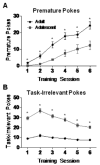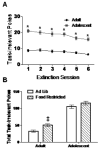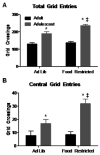Adolescents exhibit behavioral differences from adults during instrumental learning and extinction
- PMID: 20141277
- PMCID: PMC2871391
- DOI: 10.1037/a0018463
Adolescents exhibit behavioral differences from adults during instrumental learning and extinction
Abstract
Adolescence is associated with the development of brain regions linked to cognition and emotion. Such changes are thought to contribute to the behavioral and neuropsychiatric vulnerabilities of this period. We compared adolescent (Postnatal Days 28-42) and adult (Postnatal Day 60+) rats as they performed a simple instrumental task and extinction. Rats were trained to poke into a hole for a food-pellet reinforcer. After six days of training, rats underwent extinction sessions in which the previously rewarded behavior was no longer reinforced. During extinction, we examined the effects of continued presentation of a cue light and food restriction. Adults and adolescents exhibited similar performance during training, although adolescents made more task-irrelevant pokes, consistent with increased exploration. Adults made more premature pokes, which could indicate a more exclusive focus on the task. During extinction, adolescents made more perseverative (previously reinforced) pokes than adults. This behavior was strongly modulated by the combination of motivational factors present (food restriction and cue light), indicating that adolescents were differentially sensitive to them. Furthermore, food restriction induced greater open-field activity in adolescents but not in adults. Thus, as the neural circuitry of motivated behavior develops substantially during adolescence, so too does the behavioral sensitivity to motivational factors. Understanding how such factors differently affect adolescents may shed light on mechanisms that lead to the development of disorders that are manifested during this period.
(c) 2009 APA, all rights reserved.
Figures







Similar articles
-
A comparison of adult and adolescent rat behavior in operant learning, extinction, and behavioral inhibition paradigms.Behav Neurosci. 2011 Feb;125(1):93-105. doi: 10.1037/a0022038. Behav Neurosci. 2011. PMID: 21319891
-
Adolescent alcohol exposure reduces behavioral flexibility, promotes disinhibition, and increases resistance to extinction of ethanol self-administration in adulthood.Neuropsychopharmacology. 2014 Oct;39(11):2570-83. doi: 10.1038/npp.2014.109. Epub 2014 May 13. Neuropsychopharmacology. 2014. PMID: 24820536 Free PMC article.
-
Dynamics of neural coding in the accumbens during extinction and reinstatement of rewarded behavior.Behav Brain Res. 2004 Sep 23;154(1):125-35. doi: 10.1016/j.bbr.2004.02.003. Behav Brain Res. 2004. PMID: 15302118
-
Behavioral and neurobiological mechanisms of extinction in Pavlovian and instrumental learning.Neurobiol Learn Mem. 2014 Feb;108:52-64. doi: 10.1016/j.nlm.2013.08.012. Epub 2013 Aug 30. Neurobiol Learn Mem. 2014. PMID: 23999219 Free PMC article. Review.
-
A fundamental role for context in instrumental learning and extinction.Behav Processes. 2014 May;104:13-9. doi: 10.1016/j.beproc.2014.02.012. Epub 2014 Feb 24. Behav Processes. 2014. PMID: 24576702 Free PMC article. Review.
Cited by
-
Differences in response initiation and behavioral flexibility between adolescent and adult rats.Behav Neurosci. 2013 Feb;127(1):23-32. doi: 10.1037/a0031328. Behav Neurosci. 2013. PMID: 23398439 Free PMC article.
-
Age differences in appetitive Pavlovian conditioning and extinction in rats.Physiol Behav. 2016 Dec 1;167:354-362. doi: 10.1016/j.physbeh.2016.10.004. Epub 2016 Oct 11. Physiol Behav. 2016. PMID: 27737779 Free PMC article.
-
Repeated sleep restriction in adolescent rats altered sleep patterns and impaired spatial learning/memory ability.Sleep. 2012 Jun 1;35(6):849-59. doi: 10.5665/sleep.1888. Sleep. 2012. PMID: 22654204 Free PMC article.
-
Reward-centricity and attenuated aversions: An adolescent phenotype emerging from studies in laboratory animals.Neurosci Biobehav Rev. 2016 Nov;70:121-134. doi: 10.1016/j.neubiorev.2016.08.015. Epub 2016 Aug 11. Neurosci Biobehav Rev. 2016. PMID: 27524639 Free PMC article. Review.
-
Age and sex differences in behavioral flexibility, sensitivity to reward value, and risky decision-making.Behav Neurosci. 2018 Apr;132(2):75-87. doi: 10.1037/bne0000235. Epub 2018 Feb 26. Behav Neurosci. 2018. PMID: 29481101 Free PMC article.
References
-
- Adriani W, Chiarotti F, Laviola G. Elevated novelty seeking and peculiar d-amphetamine sensitization in periadolescent mice compared with adult mice. Behav Neurosci. 1998;112(5):1152–1166. - PubMed
-
- Adriani W, Laviola G. Elevated levels of impulsivity and reduced place conditioning with d-amphetamine: two behavioral features of adolescence in mice. Behav Neurosci. 2003;117(4):695–703. - PubMed
-
- Adriani W, Laviola G. Windows of vulnerability to psychopathology and therapeutic strategy in the adolescent rodent model. Behav Pharmacol. 2004;15(5-6):341–352. - PubMed
-
- Andersen SL, Thompson AT, Rutstein M, Hostetter JC, Teicher MH. Dopamine receptor pruning in prefrontal cortex during the periadolescent period in rats. Synapse. 2000;37(2):167–169. - PubMed
-
- Andrucci GL, Archer RP, Pancoast DL, Gordon RA. The relationship of MMPI and Sensation Seeking Scales to adolescent drug use. J Pers Assess. 1989;53(2):253–266. - PubMed

